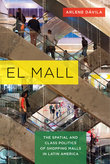El Mall: The Spatial and Class Politics of Shopping Malls in Latin America

The shopping mall has proven to be an unsustainable and declining form of consumption across the US and Europe. Yet Latin America has seen rapid construction of malls in recent years, as part of a boom in real estate investment and speculation catering to the growing middle class.
Dávila’s analysis concentrates on Bogotá but refers often to other parts of Latin America (although she acknowledges the heterogeneity of Latin American middle classes). The regional trend of shopping mall development is accelerated in Colombia, where the number of malls tripled from 2003 to 2014, and where legacies of inequality and insecurity have aided the image of malls as desirable forms of partitioned urban space. Overall, Dávila treats the mall as a microcosm of wider changes in governance, economics and social relations.
One such area is consumer citizenship. Dávila considers consumer lifestyles one key marker of the “new middle classes” in Latin America. Mall-centric lifestyles have contributed to the rise of personal credit and have created a way for members of the middle classes to present their identity and recognize each other.
This type of consumer citizenship is heavily influenced by globalization, through multinational investment streams but also through global chains of branding and distribution. Colombia has historically had close ties with the US, and the extension of US financial interests and the US-focused International Council of Shopping Centers has perhaps been unsurprising in Bogotá.
Both globally and domestically, Bogotá is experiencing heavy pressure to make its land available to mall developers. Land ownership is heavily concentrated with Colombia’s elite commercial families, and commercial property in Bogotá’s high-end malls costs up to US$ 300/square metre, one of the costliest rates in the world. According to Dávila, “shopping malls are Bogotá’s primary engine of urban growth” (page 72). Thus there is much contestation over this very valuable land. This contestation is playing out in urban planning; Dávila says that in Colombia, developers of shopping malls have a disproportionate level of influence over planning.
Shopping malls are also sites of contestation about appropriate class relations. While some optimists have argued that malls can be democratizing spaces of inter-class contact and harmony, Dávila takes a more nuanced view. Malls themselves are differentiated along class lines, with those in the high-income northern parts of the city carrying different brands and clearly catering to different customer bases.
There are many ways of fostering exclusion. Parking is costly at exclusive malls, and guards prevent street vendors and other “undesirable” people from entering upscale malls. Malls have driven a reconfiguring of public and private space in Bogotá, encouraging formal, indoor entrepreneurship rather than informal street life. Security was the biggest single expense for most of the mall managers Dávila interviewed, at roughly a third of their budgets. Racial profiling of dark-skinned youth have led to protests in the very spaces that sought to exclude them. Overall “there is a class order to the mall, whereby people generally visit malls according to region and class, staying away from shopping malls and other spaces in which they are considered out of place” (page 165).
All this is part of Dávila’s larger critique, of the idea that malls are public goods that should be championed for their accessibility. Yes, she acknowledges,
“according to governmental statistics, shopping malls are the number one entertainment choice for Colombian families…What this shows is that many families are claiming shopping malls as public space, which is not surprising considering that decades of pro-shopping mall urban planning have made shopping malls one of the most accessible urban fixtures for most Colombians.” (page 168)
However, this view of public space may be displacing a more progressive vision of an inclusive city:
“In sum, public space is less a question of design than of politics, and it demands the type of social legislation and contexts geared not only to protecting or promoting public space as an empty goal but rather to its access and uses by all people. Under these broader criteria, it is evident that cities like Bogotá have seen a narrowing of public space alongside a spread of retail real estate square footage and that shopping malls fall short of any definition of truly accessible public space…What we may not be able to stop…is the mallification of our cities and the spread of the logics of security, surveillance, commodification, and precarity into more aspects of everyday life. These are the logics that make it seem normal that a city already saturated with shopping malls would build even more and bigger malls while its public infrastructure crumbles.” (171–172)
Further reading:
Dávila, Julio D (2009), “Being a mayor: the view from four Colombian cities”, Environment and Urbanization Vol 21, No 1, pages 37–57, available at http://eau.sagepub.com/content/21/1/37.abstract.
Malone, Karen (2002), “Street life: youth, culture and competing uses of public space”, Environment and Urbanization Vol 14, No 2, pages 157–168, available at http://eau.sagepub.com/content/14/2/157.abstract.
Stillerman, Joel and Rodrigo Salcedo (2012), “Transposing the Urban to the Mall: Routes, Relationships, and Resistance in Two Santiago, Chile Shopping Centers”, Journal of Contemporary Ethnography Vol 41, No 3, pages 309–336, available at http://scholarworks.gvsu.edu/soc_articles/1/.
Book note prepared by Christine Ro
Search the Book notes database
Our Book notes database contains details and summaries of all the publications included in Book notes since 1993 - with details on how to obtain/download.
Use the search form above, or visit the Book notes landing page for more options and latest content.
For a searchable database for papers in Environment and Urbanization, go to http://eau.sagepub.com/

